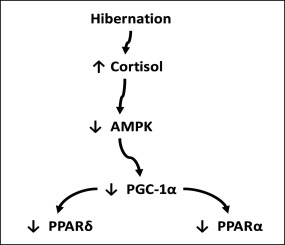当前位置:
X-MOL 学术
›
Comp. Biochem. Physiol. A Mol. Integr. Physiol.
›
论文详情
Our official English website, www.x-mol.net, welcomes your
feedback! (Note: you will need to create a separate account there.)
Regulation of metabolism during hibernation in brown bears (Ursus arctos): Involvement of cortisol, PGC-1α and AMPK in adipose tissue and skeletal muscle.
Comparative Biochemistry and Physiology A: Molecular & Integrative Physiology ( IF 2.1 ) Pub Date : 2019-10-25 , DOI: 10.1016/j.cbpa.2019.110591 Chantal A Vella 1 , O Lynne Nelson 2 , Heiko T Jansen 3 , Charles T Robbins 4 , Andrew E Jensen 5 , Silvana Constantinescu 6 , Marcia J Abbott 7 , Lorraine P Turcotte 5
Comparative Biochemistry and Physiology A: Molecular & Integrative Physiology ( IF 2.1 ) Pub Date : 2019-10-25 , DOI: 10.1016/j.cbpa.2019.110591 Chantal A Vella 1 , O Lynne Nelson 2 , Heiko T Jansen 3 , Charles T Robbins 4 , Andrew E Jensen 5 , Silvana Constantinescu 6 , Marcia J Abbott 7 , Lorraine P Turcotte 5
Affiliation

|
The purpose of this study was to investigate changes in expression of known cellular regulators of metabolism during hyperphagia (Sept) and hibernation (Jan) in skeletal muscle and adipose tissue of brown bears and determine whether signaling molecules and transcription factors known to respond to changes in cellular energy state are involved in the regulation of these metabolic adaptations. During hibernation, serum levels of cortisol, glycerol, and triglycerides were elevated, and protein expression and activation of AMPK in skeletal muscle and adipose tissue were reduced. mRNA expression of the co-activator PGC-1α was reduced in all tissues in hibernation whereas mRNA expression of the transcription factor PPAR-α was reduced in the vastus lateralis muscle and adipose tissue only. During hibernation, gene expression of ATGL and CD36 was not altered; however, HSL gene expression was reduced in adipose tissue. During hibernation gene expression of the lipogenic enzyme DGAT in all tissues and the expression of the FA oxidative enzyme LCAD in the vastus lateralis muscle were reduced. Gene and protein expression of the glucose transporter GLUT4 was decreased in adipose tissue in hibernation. Our data suggest that high cortisol levels are a key adaptation during hibernation and link cortisol to a reduced activation of the AMPK/PGC-1α/PPAR-α axis in the regulation of metabolism in skeletal muscle and adipose tissue. Moreover, our results indicate that during this phase of hibernation at a time when metabolic rate is significantly reduced metabolic adaptations in peripheral tissues seek to limit the detrimental effects of unduly large energy dissipation.
中文翻译:

棕熊(Ursus arctos)冬眠过程中的代谢调节:皮质醇,PGC-1α和AMPK参与脂肪组织和骨骼肌的活动。
这项研究的目的是调查棕熊骨骼肌和脂肪组织在食欲亢进(9月)和冬眠(1月)期间已知的新陈代谢细胞调节因子的表达变化,并确定是否已知信号分子和转录因子能够响应棕熊的变化。细胞能量状态参与这些代谢适应的调节。冬眠期间,血清中的皮质醇,甘油和甘油三酸酯水平升高,骨骼肌和脂肪组织中的蛋白质表达和AMPK的激活降低。在冬眠的所有组织中,共激活因子PGC-1α的mRNA表达均降低,而转录因子PPAR-α的mRNA表达仅在股外侧肌和脂肪组织中降低。在冬眠期间,ATGL和CD36的基因表达未改变;然而,HSL基因在脂肪组织中的表达减少。在冬眠期间,所有组织中脂肪生成酶DGAT的基因表达和外侧股外侧肌中FA氧化酶LCAD的表达均降低。休眠状态下,脂肪组织中葡萄糖转运蛋白GLUT4的基因和蛋白表达降低。我们的数据表明,高皮质醇水平是冬眠过程中的关键适应因素,并将皮质醇与AMPK /PGC-1α/PPAR-α轴的活化降低相关,可调节骨骼肌和脂肪组织的新陈代谢。而且,
更新日期:2019-10-25
中文翻译:

棕熊(Ursus arctos)冬眠过程中的代谢调节:皮质醇,PGC-1α和AMPK参与脂肪组织和骨骼肌的活动。
这项研究的目的是调查棕熊骨骼肌和脂肪组织在食欲亢进(9月)和冬眠(1月)期间已知的新陈代谢细胞调节因子的表达变化,并确定是否已知信号分子和转录因子能够响应棕熊的变化。细胞能量状态参与这些代谢适应的调节。冬眠期间,血清中的皮质醇,甘油和甘油三酸酯水平升高,骨骼肌和脂肪组织中的蛋白质表达和AMPK的激活降低。在冬眠的所有组织中,共激活因子PGC-1α的mRNA表达均降低,而转录因子PPAR-α的mRNA表达仅在股外侧肌和脂肪组织中降低。在冬眠期间,ATGL和CD36的基因表达未改变;然而,HSL基因在脂肪组织中的表达减少。在冬眠期间,所有组织中脂肪生成酶DGAT的基因表达和外侧股外侧肌中FA氧化酶LCAD的表达均降低。休眠状态下,脂肪组织中葡萄糖转运蛋白GLUT4的基因和蛋白表达降低。我们的数据表明,高皮质醇水平是冬眠过程中的关键适应因素,并将皮质醇与AMPK /PGC-1α/PPAR-α轴的活化降低相关,可调节骨骼肌和脂肪组织的新陈代谢。而且,











































 京公网安备 11010802027423号
京公网安备 11010802027423号